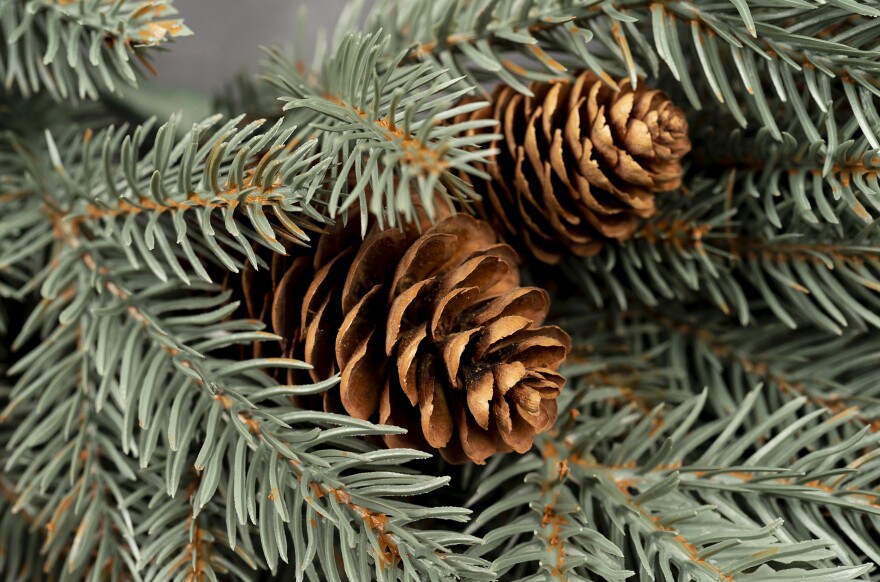Dressing up your front door, fence posts and porch steps for the winter holidays can be a great exercise in creativity and frugality.
Armed with natural materials from your own lawn and a few plant containers that you already own, and you're on your way to crafting unique holiday decorations.
First, gather up a few necessary materials for this project. Head to your garage or garden shed and pull out those plant containers that you just emptied as you were putting your gardens to bed for winter.
It's important to choose plant containers made from plastic. Using clay pots or ones made from terra cotta filled with potting soil could crack in the cold and fluctuating temperatures during the winter months.
Once you've chosen your containers, fill them with some potting soil.
Then, stand in your yard and scan around. Focus in on any evergreen trees and shrubs you might have in your (or your neighbors'!) landscape. Also, be on the lookout for interesting bare branches or dried seed pods and flower heads. If you have trees and shrubs with brightly-colored berries, put those in your sights, too.
Next, grab a bucket or basket and some clippers or scissors and start gathering materials. If you are taking clippings and boughs from your neighbors' trees, be sure to get their okay first.
Look for evergreens like spruce, cedar, pine and fir, and cut small boughs from the tree or shrub. Take some cuttings of rhododendron and add those to your container. Try not to get a portion with the buds on it because those are next spring's rhododendron flowers.
Once you've got a collection of various natural materials, you can recreate a design that you've found in a photo or image online that you like or you can freestyle it and make your own design.
Push the branches and boughs into the potting soil, then decorate it further with colorful things like red holly or winter berries. Snow berries and coral berries also look beautiful and even crab apples and red sumac drupes can add color to your creation.
And if you're crafty and have some cans of spray paint on hand, spray some of the twigs, seed pods or cones with gold, red or green paint to add a pop of color to your container.
Ornamental grasses, pine cones and acorns can also provide some texture to your creation.
If you've got kids or grandkids, this can be a fun project to get them involved, from adding the potting soil, to foraging for fun natural materials.
Place your newly decorated container outside your house on a porch or front step. And even try adding some bird seed and see who comes to visit all winter long.
Here's another "speed-weeding" lightning round of questions. This time, learn how to properly put your gardens and no-dig beds to bed for winter:
Q: Should I top dress with compost or straw?
A: No. And yes! Don't add compost to your garden beds this time of year because it will just sit there. Any nutrients in the compost will erode away because of rain, snow and winter winds. But yes, do add straw! It will protect the soil.
Q: Should I incorporate all of that straw into the soil or just leave it?
A: Leave the straw as a layer on top, because if you incorporate it into the soil, you're going to break one of the principles of "no-dig" gardening. Digging would disturb that soil. Instead, just use as layers on top and leave it there. The microbes and earthworms will find it and do the work.
Q: Should I pull up current vegetables and leave the stalks and leaves in my no-dig garden bed or compost them elsewhere?
A: If you had healthy vegetables and plants with not a lot of insects and diseases, try, the "chop and drop" method.
Take your hedge trimmer and chop the plant stalks, stems and leaves into little pieces, and leave them there. This will provide a good layer to protect the soil.
If you had some plants that were heavily diseased, like tomato plants with blight, for example, cut the whole plant off at the soil line and remove it from your garden area. Leaving the diseased stalks there will invite it to come back in spring. Then, add a layer of hay or straw to cover the soil.
Q: I followed Charlie's "no dig" method last spring. It was a big success! Anything I need to do to put it to bed for winter?
A: Keeping the soil in your no-dig garden bed covered at all times is really important. You can keep the soil covered with numerous natural materials. Layers of hay, straw, chopped leaves or grass clippings all work well.
That added layer is going to protect the microbes in the soil from erosion and fluctuating temperatures throughout the winter.
Next spring, come in with some compost, add that directly on the top layer - again, no digging! - and then plant right into that new compost.
All Things Gardening is powered by you, the listener! Send your gardening questions and conundrums and Charlie may answer them in upcoming episodes.
You can also leave a voicemail with your gardening question by calling Vermont Public at 1-800-639-2192.
Hear All Things Gardening during Weekend Edition with Vermont Public host Mary Williams Engisch, Sunday mornings at 9:35.
Have questions, comments or tips? Send us a message or get in touch by tweeting us @vermontpublic. We've closed our comments. Read about ways to get in touch here.








